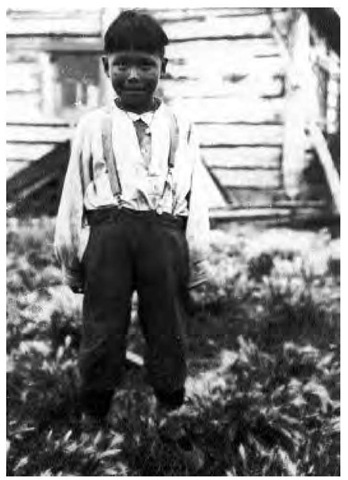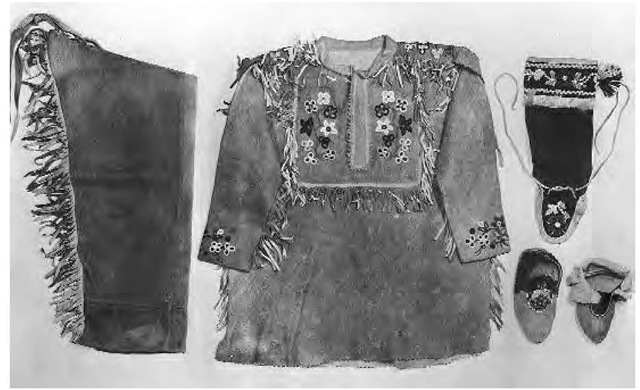Dogrib, from their self-designation, Thlingchadinne, "Dog Flank People," signifying their legendary descent from a dog. The people also call themselves Done, "men" or "People." They are culturally related to the Slavey.
Location In the nineteenth and twentieth centuries, Dogribs lived between Great Slave and Great Bear Lakes, Northwest Territories, an area that included both forest and tundra.
Population There were perhaps 1,250 Dogribs in the late seventeenth century. The mid-1990s population was about 3,000.
Language Dogrib is a Northeastern Athapaskan language.
Historical Information
History The people may have come to their historic location from the south and east. They first encountered non-natives in either 1744 or 1771. The first trade posts were built in the 1790s.
The fur trade and provisioning were the dominant economic activities throughout the nineteenth century, during which time the people gradually began settling around trade posts. Fort Rae (1852) marked the first permanent local post and the beginning of extensive contact for most Dogribs with non-natives. Fur trading became much more important at that time, especially after 1900 and the end of the Hudson’s Bay Company monopoly. In addition to the usual fur-bearing animals, musk-ox robes were also in demand.
The people suffered severe epidemics from 1859 onward. Most Dogribs had been baptized Catholic by 1870. The first treaty with Canada was signed in 1900. In 1920, the Dogrib stopped accepting government payments as a protest against hunting and fishing restrictions. This issue was resolved when they accepted a special designation, but the signed agreement was later lost.
As part of a 1921 treaty, the leader Monphwi became a "government chief," and band leaders formed an official council. There was a brief local gold rush, at Great Bear Lake, in 1930. The people were largely monolingual and semitraditional through the 1940s.
A Bear Lake Dogrib boy in 1924. The European style of dress illustrates the degree of acculturation even at this early date.
Religion People acquired guardian spirits in dreams. They also made offerings to spirits that inhabited bodies of water. Shamans caused and cured disease and foretold the future.
Government There were traditionally four autonomous bands, or divisions (Lintchanre, Takfwelottine, Tsantieottine, and Tseottine). Band leadership was informal; a chief hunter had helpful spiritual power but little authority. Bands were composed of local hunting groups. Membership in all groups was fluid.
Customs When a young man killed his first game, his peers would strip him and wish him continued good luck. Only indirect address was considered polite. The people enjoyed games and dancing; the latter was often accompanied by group male singing.
People’s names often changed at the birth of their children. Brothers and sisters remained reserved with each other, as did a man with his brother-in-law and father-in-law. Men might have more than one wife, but they were required to serve their new in-laws for a period of time after the marriage. There may have been a practice of wrestling for wives as well as some female infanticide.
The elderly or ill were often abandoned. Streamers attached to burial scaffolds were meant to placate spirits of the dead. Mourners destroyed most of their property, and the women slashed their bodies. A memorial feast was held a year following the death.
Dwellings Dogribs lived in conical tipis covered with as many as 40 caribou skins sewn together with sinew or babiche. The sides were covered with snow in winter. There were also some rectangular pole-and-brush winter huts. In the coldest weather, people often slept outside in skin bags to avoid the interior drafts.
Diet Men hunted mainly caribou, which they snared in pounds and speared in lakes, in the forests, and on short trips onto the tundra. They also hunted musk ox, moose, hare and other small game, fowl, and birds. There was some fishing; later, with decreasing game in the nineteenth century, fish gradually assumed a greater importance in the diet. Fish and meat were roasted, stone boiled (in caribou stomach-lined holes), smoked, dried in strips, or mixed with marrow and perhaps berries and made into pemmican.
Women gathered some berries and other plant foods as well as poplar sap. Food taboos included the weasel, wolf, skunk, and dog.
Key Technology Fish were taken with the use of dams, weirs, and willow-bark fishnets. Men hunted with bows and arrows and snares. Food was wrapped in hide and cached on poles or platforms. The main raw materials were caribou parts and wood.
Trade The people exported native copper to the Slavey and Yellowknife, among other groups. They also traded in caribou skins, flint, chert, and pyrites as well as Inuit bone and ivory knives. They exported moose and fish products.
Notable Arts Women decorated a number of items, such as moccasins, shirts, and bags, with woven quillwork or moose hair. Musical instruments included drums and caribou-hoof rattles.
Transportation Most transportation was overland using sleds and snowshoes. Burdens were carried with a tumpline and chest strap. Birch-bark canoes were caulked with spruce gum.
Dress Typical clothing included a tailored skin shirt, breechclout, leggings, and moccasins. The latter two were separate. Winter items included moose-hide blankets, fur robes, hats, and mittens.
War and Weapons Enemies included the Yellowknife, Chipewyan, and Cree. A decisive military victory in 1823 destroyed the threat from the first group. War leaders were chosen on an ad-hoc basis. All enemies, except young women, were killed whenever possible.
Contemporary Information
Government/Reservations Contemporary bands include Follow the Shore People, Filth Lake People, Edge of the Woods People, People Next to Another People, Bear Lake Dogrib, and Connie River People. Roughly 70 percent of the population lives at Rae. Other population centers include Yellowknife, Fort Franklin, and Edzo, Northwest Territories. A strong chief and council have been elected since the 1970s.
Economy Hunting, fishing, and trapping remain important. There is some wage labor as fishing guides and construction laborers. Women work at producing crafts.
Legal Status The bands listed under "Government/ Reservations" are federally recognized. The Treaty 11 Dogrib, formerly part of the larger Dene/Metis claim (see Kutchin), filed their own land claim in 1992. According to two interim agreements in 1994, the people will win the withdrawal of about 13,000 square kilometers of land from around four Dogrib communities as well as participation in the decision-making process concerning the North Slave region.
Dogrib moccasins, moosehide coat, and moosehide leggings such as these would have made up late traditional dress.
Daily Life Band membership is still recognized and considered important. Although the language is still in use, there is a high degree of acculturation among the people. Modern housing, non-native education, welfare eligibility, and medical services date from the 1960s. Most Dogribs are Catholic. Their lands are being rapidly developed, mainly by mineral extraction industries, without Dogrib input. This had led to a decision to negotiate a land claim settlement with the Canadian government in an effort to gain some control over development.


